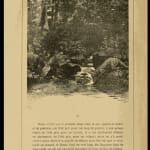

Page 12 from the printed Victor Hugo’s L’homme qui rit published by Albin Michel, Paris. c.1886. Public Domain. Image digitized by the University of Toronto, Joseph Sablé Centre for 19th Century French Studies.
GEORGE ROCHEGROSSE
George Rochegrosse (1859-1938) developed an unmatched ability to render realistic compositions from imagined scenes with sublime clarity. The environment Victor Hugo describes begins, ‘le rencontrant dans un hallier, près d’un ruisseau d’eau vive’ (meeting him in a thicket, near a stream of white water) and continues to detail an important observed ecological behavior that solidifies the initial encounter between the two companions, ‘l’avait pris en estime en le voyant pêcher des écrevisses avec sagesse et prudence’ ([Ursus] held him [Homo] with respect upon seeing him catch crayfish with wisdom and care). Hugo presents the reader with a physical location known in literature and oral history as a meeting place between humans and the supernatural realm. Hugo further explores the dichotomy between wilderness and sophistication in the novel by regarding Ursus’ best friend, not as a dog, but a wolf. An animal with primal associations depicted in the earliest paintings of the natural world. A clever pun of the Latin proverb Homo homini lupus est, the character of Homo is written to satire the civilized reality of the novel that manifests as Gwynplaine, the man with the perpetual smile.
The present composition by Rochegrosse served as the principal design for printmaker Fortuné Méaulle (1844-1916), who then created the wood-engravings for the 1886 Hugues edition. On this page, Méaulle did not include the running head or page number to allow space for the full image margins (see below). Similar examples of Rochegrosse’s original works for L’Homme qui rit can be found in the collections of the Morgan Library & Museum, and the Maison de Victor Hugo Hauteville House.
Rochegrosse often depicted characters emerging from abject circumstances in narratives where they challenge opposing forces of decadence and moral vice. To this aim, Rochegrosse’s attention to light achieved an almost metaphysical quality and was a celebrated aspect of his paintings in the 19th century. In this drawing, the inclusion of sunlight on the illuminated plant leaves and the reflected surface of moving water capture the artist’s expert skill in drafting.
Rochegrosse is widely known for scenes of battle, even his drawings remain focused on turbulent or deeply introspective moments in narratives. The present scene however is not of a miserable quality, rather it is one of companionship. A tender moment of human awareness in a novel otherwise founded upon imagined corrupt and violent social dynamics in the 17th century.
Provenance
Provenance:
Paris Art Market;
Private Collection, Ohio;
Cleveland Museum of Art, Ohio (bequeathed by the above);
Private Collection, New York

